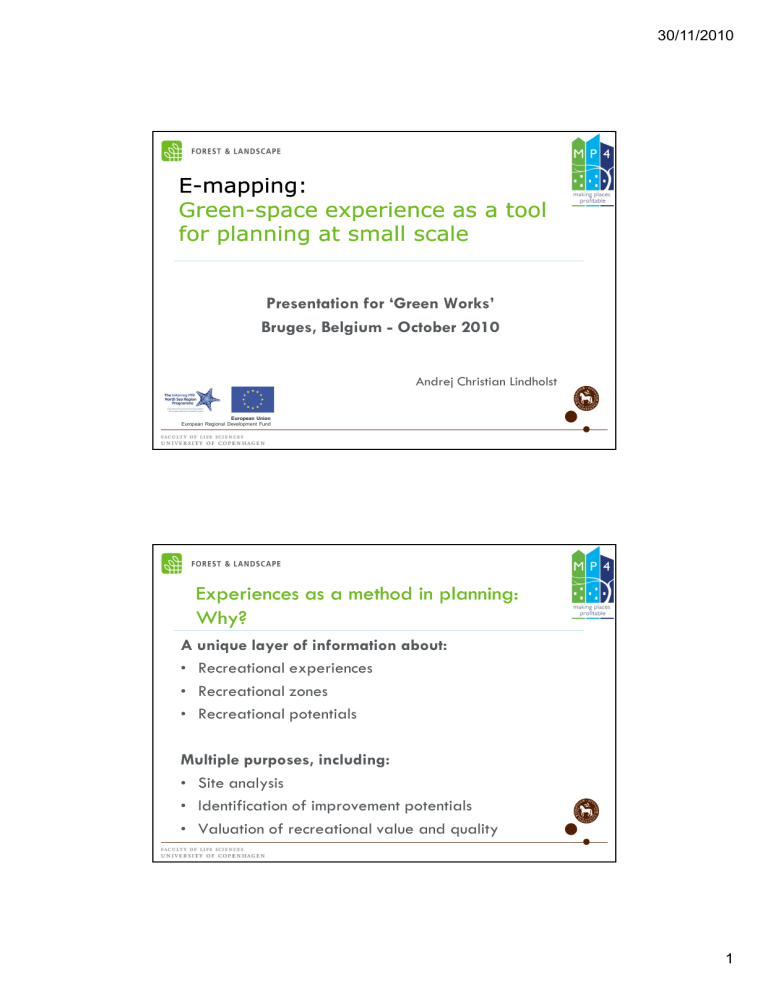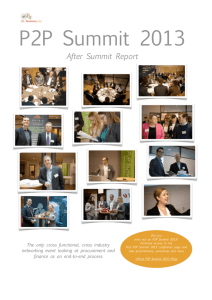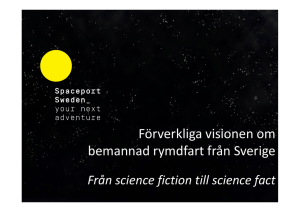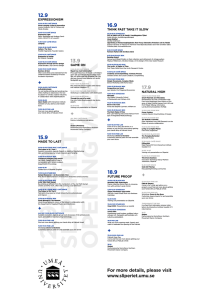E-mapping: Green-space experience as a tool space experience as

30/11/2010
Presentation for ‘Green Works’
Bruges, Belgium - October 2010
Andrej Christian Lindholst
European Union
European Regional Development Fund
•
•
•
A unique layer of information about:
Recreational experiences
Recreational zones
Recreational potentials
•
•
•
Multiple purposes, including:
Site analysis
Identification of improvement potentials
Valuation of recreational value and quality
1
•
•
•
•
An experience is a ‘memorable personal sensation’, a ‘state in the mind/body’: Created by sensing, perceptions, feelings, moods, thoughts, attitudes, preferences, interpretations and reflections.
Environmental psychology: Humans experience the surroundings in certain ‘categories’.
Evolutionary speaking the categories have a function and therefore a value (e.g. a ‘shelter’ or ‘hunting ground’).
The categories are partly inherent in our ‘body’ (biological) and partly adapted through learning (cultural) .
• The experience is more important than the physical characteristics.
• If sought after experiences is present in a green space it will increase the recreational value and the recreational use .
• Eight experiences cover – by and large – all recreational purposes behind visits in green spaces (at least in Sweden).
30/11/2010
2
NATURE Sensation of the free growing, untouched, vital, an encounter with nature on its own conditions.
SERENE
Sensation of an undisturbed peacefulness, to be on one’s own, in safety and withdrawn in one with nature/surroundings.
RICHNESS IN SPECIES Sensation of richness in plants, insects and/or animals.
SPACE
REFUGE
PROSPECT
Sensation of an independent, inter-connected and special ’universe’.
Sensation of safe and provided surroundings and facilities for expression, play and interactions with other people.
Sensation of open and free surroundings for expression and activity.
SOCIAL
CULTURE
Sensation of organized and entertaining scene and get-together with other people.
Sensation of cultivated, man-made surroundings shaped by history and culture.
Adapted from Grahn & Stigsdotter 2010 / Nordh 2010
• ’Nature-like’ experiences (‘nature’, ‘serene’, ‘rich in species’) is positively related with mental health
(stress relief and restoration).
• Experiences of ‘nature’, ‘serene’ and ‘refuge’ are the most sought after ’everyday experiences’.
• Other experiences are sought after in weekends and special occasions e.g. ‘prospect’, ‘social’ and
‘cultural’. Visitors are willing to travel longer.
• Different user groups seek different experiences.
30/11/2010
3
‘E--mapping’ Step by step
•
•
•
•
Learn and adopt the experiences
On-site visits / analysis
Identify location (zones) and perceived strength of experiences
Register ‘zones’ on a map / register experiences within the zones in a table
Tools for on-site analysis
• Print out of aerial photo (e.g. google) + pen
• Photos/descriptions for examples/documentation
• GIS?
30/11/2010
2
1
5
15
13
14 3
4
10
9
12
11
8
6
7
4
SPACE
9
10
11
12
13
14
15
7
8
5
6
3
4
1
2
-
-
-
-
-
1
1
1
1
Nature Rich in species
-
-
-
-
-
-
-
-
-
-
-
-
-
-
-
-
-
1
-
-
1
SPACES AND EXPERIENCES IN SKT. JØRGENS PARK
Serene Space
EXPERIENCE
Refuge Prospect Social
-
-
-
-
-
-
-
1
2
-
1
1
-
-
-
-
-
-
-
(1)
-
-
-
-
-
1
-
-
-
-
-
1
2
-
-
-
-
-
-
-
-
-
-
1
-
-
-
-
-
-
-
-
(2)
1
-
-
-
1
2
-
-
-
-
-
-
1
-
(1)
-
-
-
-
-
1
-
Experiences: 1 weak 2 good 3 full - not present
Culture
-
-
-
-
-
-
-
-
-
-
-
-
-
-
-
Eriksbo, Gothenburg, Sweden
30/11/2010
5
30/11/2010
Which Experiences?
Which Experiences?
6
30/11/2010
Which Experiences?
Which Experiences?
7
30/11/2010
Eriksbo , Sweden
•
•
•
•
•
•
•
Berggren-Bärring, A.M. and P. Grahn 1995.
Grönstrukturens Betydelse För Användningen: En Jämförande Studie Av Hur Människor I Barnstugor, Skolor,
Föreningar, Vårdinstitutioner M Fl Organisationer Utnyttjar Tre Städers Parkutbud. Alnarp: Sveriges lantbruksuniversitet.
Caspersen, O.H. and A.S. Olafsson 2009.
'Recreational Mapping and Planning for Enlargement of the Green Structure in Greater Copenhagen', Urban Forestry
& Urban Greening.
Grahn, P. and U.K. Stigsdotter 2010.
'The Relation between Perceived Sensory Dimensions of Urban Green Space and Stress Restoration', Landscape and Urban Planning.
Lindström, M. and S. Jönsson 2009.
How to Measure Landscape Experiences: From Quantitaitive to Qualitative Research. Kalmar: Department of
Human Sciences, University of Kalmar.
Nordh, H., 2006.
Parkkaraktärer - ett verktyg för planering och gestaltning av grönområden. Institutionen för landskapsplanering,
Sveriges Lantbruksuniversitet, Alnarp.
Randrup, T. B., Schipperijn, J., Hansen, B. I., Jensen, F. S. Stigsdotter, U. K., 2008.
Natur og Sundhed. Skov og Landskab, Hørsholm.
Schipperijn, J, 2010 .
Use of urban green space. Forest & Landscape, Denmark.
European Union
European Regional Development Fund
8
MP4 output Guidance material
•
•
•
Available on MP4 website
Rough guide
Scientific background
Examples
European Union
European Regional Development Fund
30/11/2010
9


